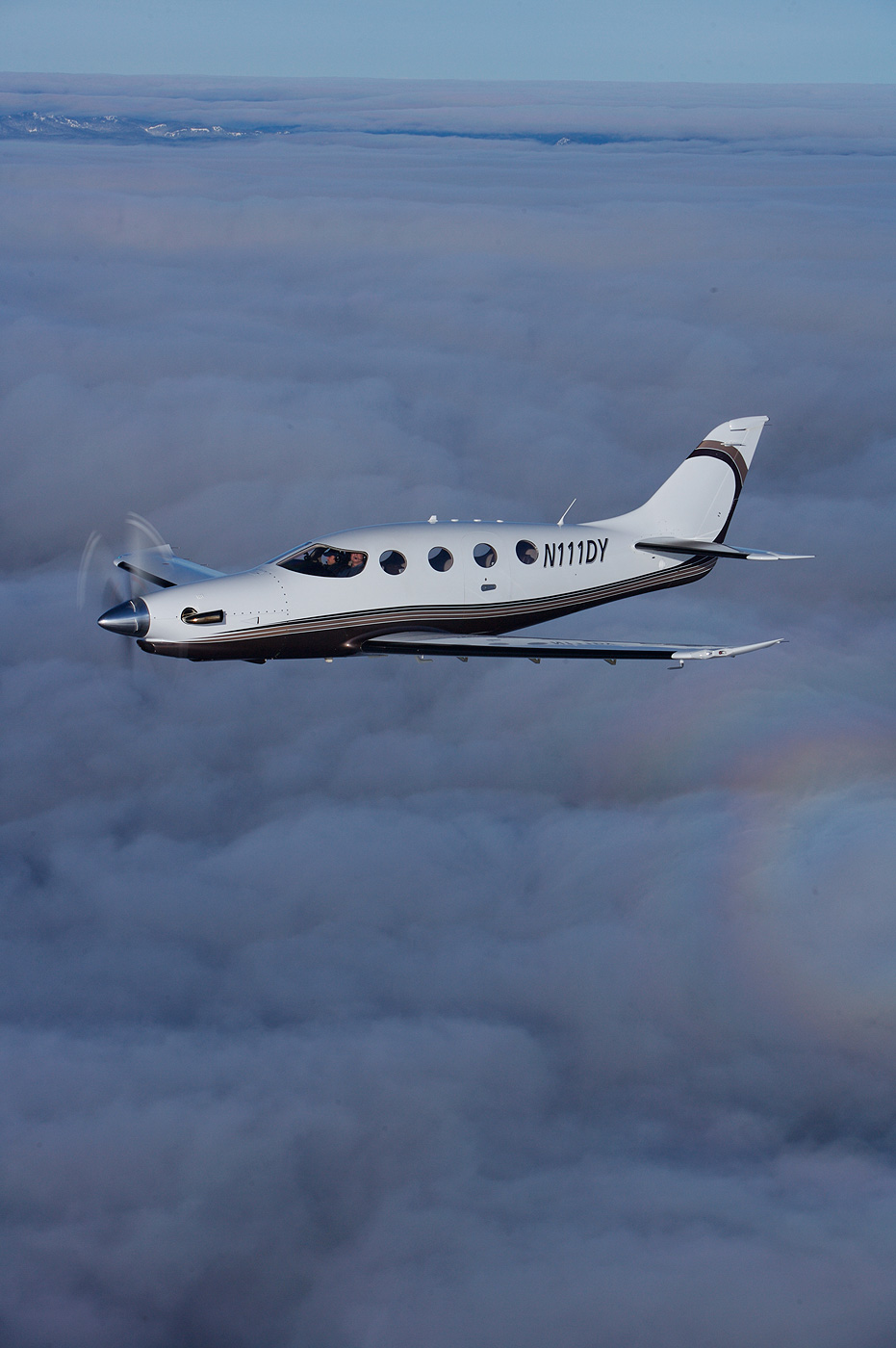Epic Lt Aircraft - The Epic LT is an American single-engine turboprop aircraft designed for use by private pilots. The Epic was a proposed certified version of the Dynasty LT to be sold as a finished aircraft prior to the bankruptcy of Epic Aircraft in August 2009 and subsequently to be acquired by new owners in April 2010.
Under the restructured company's ownership, the certified version will be called the E1000, with first deliveries originally scheduled for 2015 but delayed until 2019.
Epic Lt Aircraft

The LT was developed by Epic Air LLC of BD, Oregon, to meet the demand for a complete, high-performance, six-seat, single turboprop private jet. It has a low wing arrangement with a central arrangement of the tail on a keel. The undercarriage of the tricycle is fully extended. Carbon fiber composites have been used in its design. The engine is a 1,200 hp Pratt & Whitney PT6-67A turboprop.
Kestrel K 350
Dynasty's prototype, the Epic LT No. 14, completed over 1,000 hours of certification flight testing as of October 23, 2006, but certification was not completed in June 2009 and the company reported over 2,000 flight hours.
Flight testing of the prototype, registered as C-FJRQ, initially began in Calgary, Alberta, Canada, but the aircraft was withdrawn from the Canadian registry on 2 March 2007. It was towed back to Bd, Oregon and re-registered as N6XK. ,
Sales ceased in 2012 to be replaced by the certified Epic E1000, the 54th and final set received its Certificate of Airworthiness in December 2018, before being handed over to its owner in early 2019.
Initially, LT aircraft kits were completed by amateur builders under factory supervision at the BD factory, but some later examples were assembled with support from Epic Aircraft.
Photo Of Epic Aircraft Lt (n999pt)
On July 7, 2016, six completed Epic LT aircraft began worldwide flights operated by owner pilots. He flew at the 2016 AirVture Air Show in Oshkosh, Wisconsin.
On March 31, 2019, an Epic LT, registration RA-2151G, crashed into a field near Frankfurt-Egelsbach Airport in southwest Germany at approximately 15:30. Natalia Filova, co-owner of the Russian S7 Airlines company, one of the richest women in Russia, her father and the pilot died in the crash. The Epic LT is a 325-knot six-seat turboprop aircraft available as an owner-build kit. The manufacturer, which is still considered "experimental", is working towards certification in 2015 of an improved version of the E1000 carbon fiber aircraft. (Photo: David McIntosh)
Perhaps the most striking aircraft on display at Soma Aviation's outdoor stand (5116) is the ultra-sleek six-seater Epic LT turboprop on display at LABACE. The Vimana is a revolutionary high-performance carbon fiber vehicle that has caused quite a stir in its home country, the United States. SOMA is now looking to introduce a certified version specially designed for the Brazilian market.

In addition to its impressive performance, with a maximum cruise speed of 325 knots and a climb rate of 3,000 feet per minute, the Epic LT has the distinction of being a complete aircraft, although the aircraft is assembled by the owners in Epic's Bend, Oregon. Is. convenience. For a shed less than $2 million, a new owner can purchase an aircraft kit, receive instructions, tools and assistance for assembling and dismantling it, as well as a flight test and pilot training package. Could The result of the construction was an aircraft equipped with Pratt & Whitney Canada PT6A-67A engines with a power of 1200 hp. and a Hartzell four-blade fully feathered propeller. The aircraft is equipped to a luxury standard and equipped with three Garmin G900X avionics screens including synthetic vision technology.
Epic Aircraft Plans To Certify Epic Lt Turboprop Single In Late 2014
The Epic Design is currently available as an LT flight under the Experimental classification, which means it cannot be leased. However, Epic is currently working on achieving full certification by 2015 for an improved aircraft called the Epic E1000. The improvements would include raising the certified ceiling to 34,000 feet from the current maximum of 28,000 feet. The additional ceiling, which can be reached in 15 minutes, will not only provide more weather allowance, but also reduce fuel consumption during cruise. At an economical cruising speed of 265 knots, the E1000 has a range of 1,650 nautical miles. This figure drops to 1,385 nautical miles at 325 knots with a maximum number of passengers.
Soma Aviation became the Brazilian dealer earlier this year, and one of the first actions was to order LT kits to showcase the company in Brazil. The aircraft is currently under construction and should be completed by the end of 2013. To meet the rules, at least 51 percent of aircraft kits must be assembled by hobbyists, which means about 12 weeks or more at the Epic factory working on the aircraft. Total production time is six to ten months, depending mainly on the designer and the availability of the PT6A-67A engine.
The LT Soma aircraft will undergo several changes according to the demands of the Brazilian market. It will be equipped with weather radar and have an inertial separator in the engine to avoid damage by foreign objects when taking off from semi-finished airstrips. The company anticipates a key market segment for operators that regularly fly to remote agricultural areas where airspace infrastructure may be poor at best. The SOMA aircraft will also feature a refined interior, including blinds and a keyboard avionics interface.
Although the LT is being used for demonstration, slots are already reserved for the E1000, and this is the aircraft that SOMA will sell in the Brazilian market. The company has made some contributions to the E1000 configuration, such as adding angle of attack indicators in the cockpit. The goal is to sell the assembled aircraft by a US dealer at a price higher than the Piper Meridian but much lower than the Pilatus PC-12. The Epic E1000 is an American one-off aircraft. Gene is a six-seat turboprop light aircraft developed by Epic Aircraft based in Oregon.
Somma Shows Brazilians How To Build Their Own Epic Lts
The project aims for the E1000 to be the fastest single-engine civilian aircraft at the time of its introduction.
Based on the Epic LT kit, the E1000 featured a cantilevered low wing, 6.5 psi cockpit with step doors in front of the rear seats, retractable tricycle landing gear and a single 1,825 hp. (1,361 kW) Pratt & Whitney Canada PT6-67A turboprop aircraft engine yielding 1,200 hp. (895 kW) in tractor configuration. The aircraft is made primarily of carbon fiber and has flaps and fins on its 43-foot (13.1 m) wingspan.
The aircraft is targeted for an empty weight of 4,400 lb (2,000 kg) and a gross weight of 7,500 lb (3,400 kg), giving a payload of 3,100 lb (1,400 kg) and a full fuel payload of 1,100 lb (500 kg). All for fuel tank and seat.

Initial performance figures show a maximum air speed of 325 knots (600 km/h), a range of 1,650 nautical miles (3,050 km), a fuel consumption of 45 US gal/h at cruising altitude, and an operating altitude of 34,000 ft.
Epic Aircraft Carbon Fiber Aircraft Achieves Faa Type Certification
In 2013 the E1000 was released, which was supposed to be the type certified version of the upgraded Epic LT aircraft. In 2014, Epic ceased sales of the entire aircraft, with the 54th and last being delivered in the second quarter of 2019.
As of February 2014, Epic had no orders for the type and initial deliveries were scheduled for the second half of 2015.
In early 2014, the project's first flight was predicted to take place in June 2015, with certification expected in later 2015.
In October 2014, the manufacturer introduced an interior design that includes features such as club seats, adjustable side tables, large pockets to accommodate tablet computers, USB sockets, cup holders and LED switches. The Garmin G1000 navigation system will include a synthetic vision system.
Epic Scratches Seven Year Certification Itch
As of May 2016, the first relevant prototype was under development, with certification expected to be completed in the fourth quarter of 2016, with customer deliveries scheduled for early 2017.
In October 2017, Epic reported a backlog of 76 aircraft valued at $3.25 million. The first prototype had accumulated 400 hours, while the second prototype, meeting production standards, was nearing its maiden flight. Russian company Epic at that time expected to complete type certification in 2018.
In 2018, the company expected to convert 85 of its reservations into firm orders and planned a production capacity of 50 aircraft per year.

As of 2018, the company had 250 employees, with certification and funds saved for the first years of production. Eight to 12 aircraft are planned for delivery in 2019, 24 in 2020, 36 in 2021 and then 50, with an end market forecast of 80 to 90 units per year. The fuselage was tested at 18 psi, nearly triple the normal pressure of 6.6 psi, while the wing was tested at 19,044 lb (8,638 kg), deflected 31 in (79 cm).
Bend Based Epic Air To Be Purchased By China Aviation
By September 2018, after 700 hours of flight testing, Epic Aircraft claimed it would meet its Year D type certification target, with production certification coming six months later.
By November 2018, the two prototypes had accumulated 800 hours, and Epic was expecting US type approval in December for type certification in early 2019 and delivery shortly thereafter, a delay of two years from earlier estimates.
In
Epic lt, epic aircraft bend oregon, epic aircraft, epic lt aircraft for sale, epic lt for sale, epic aircraft careers, epic lt price, epic aircraft lt, epic aircraft bend or, epic aircraft for sale, epic aircraft price, epic aircraft e1000
0 Comments